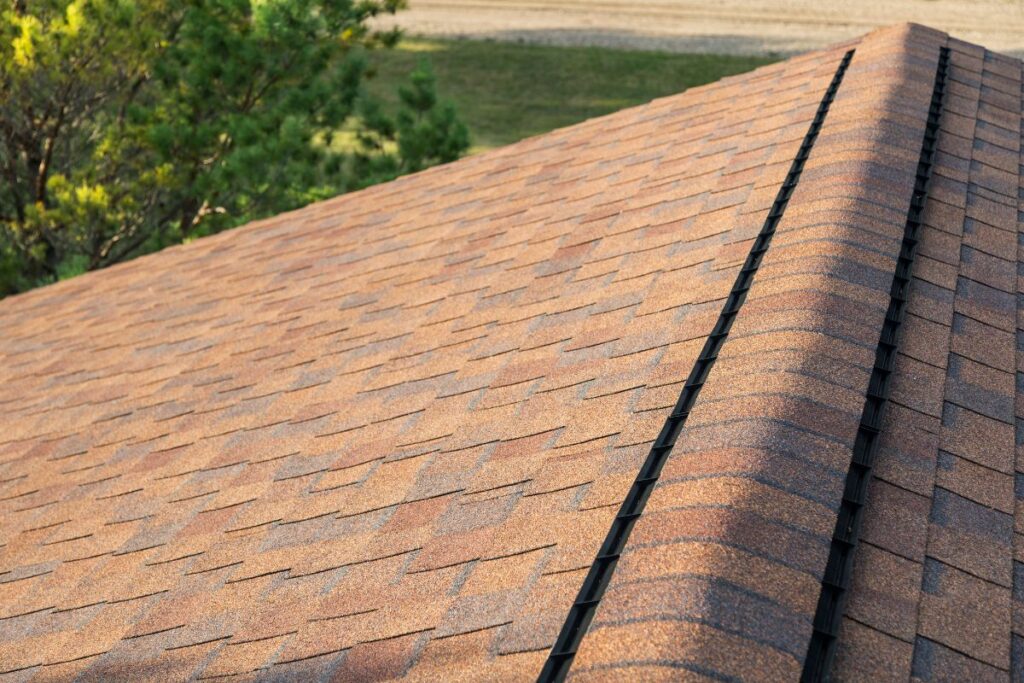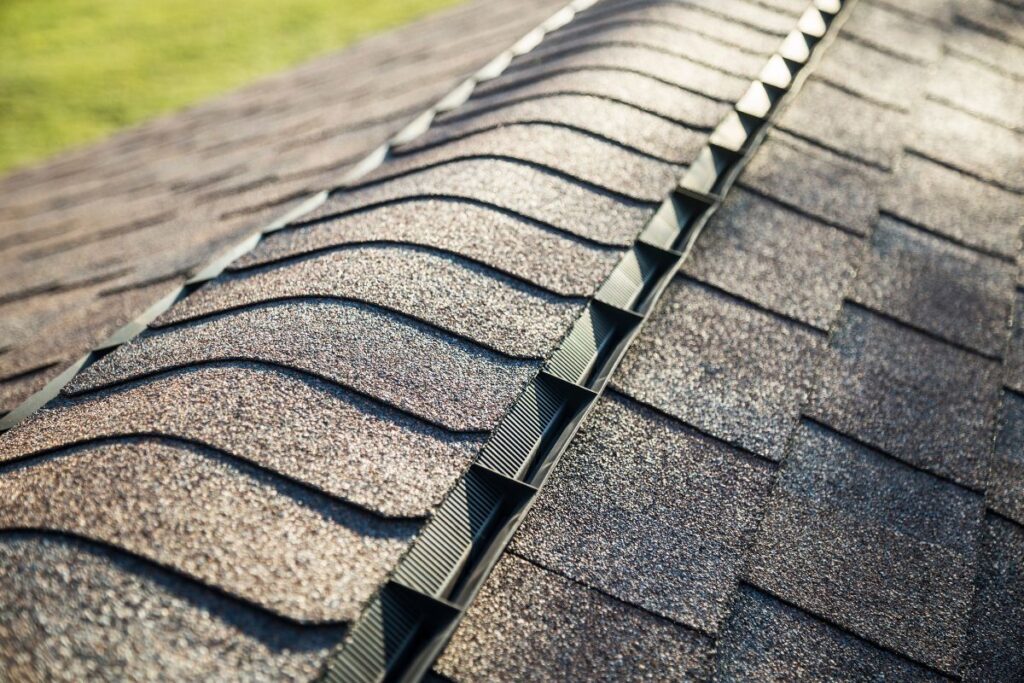While many homeowners prioritize having a strong roof, it is important to understand that proper ventilation is just as important for shielding a home from the elements. A roof may experience a number of problems in the absence of sufficient ventilation, such as moisture buildup, the growth of mold, and premature deterioration. In this, the roof ridge vent plays an essential part in making sure your roofing system is well-ventilated.
To get a better understanding, we’ll be going over the definition, function, and importance of roof ridge vents in this blog post.
What Is a Roof Ridge Vent?

An indispensable part of any roofing system is a roof ridge vent, which is placed along the roof’s peak, otherwise known as the ridge, to draw in cooler air from the soffit vents that are located below the eaves while releasing warm, humid air from the attic. This constant air circulation regulates temperature and humidity levels to avoid moisture buildup and possible damage to the roofing structure.
Ridge vents are important because they prevent ice dams, keep the internal environment of a building in balance, and reduce the need for excessive air conditioning, all of which increase energy efficiency. By only utilizing gravity and the natural flow of air, these vents allow for vertical ventilation without sacrificing the roof’s appearance.
- Ventilation: Ridge vents maintain airflow in the attic, regulating temperature and humidity. This protects roofing materials while making the home more energy efficient.
- Low Maintenance: Once installed, ridge vents need little upkeep compared to traditional systems.
- Weatherproof: Designed to withstand harsh conditions, and typically covered with ridge caps, ridge vents can effectively ventilate a roof no matter the weather.
Also Read: A Simple Guide To Roof Ridges For Homeowners (2024)
Other Benefits Of Installing A Roof Ridge Vent
- Reduced air pollution levels: They remove stagnant, polluted air, improving indoor air quality.
- Better temperature regulation: Ridge vents distribute cool air in summer and release heat, improving energy efficiency.
- Protection against pests: Their design deters rodents, insects, and pests from entering the attic.
- Longer roof lifespan: Ridge vents prevent moisture buildup, mold, and wood rot, extending the roof’s life.
- Improved aesthetics: Ridge vents blend seamlessly into the roofline, preserving the home’s appearance.
- Moisture control: Ridge vents prevent condensation and moisture accumulation, reducing mold and damage risks.
- Increased comfort: Consistent attic temperature maintained by ridge vents enhances overall comfort.
- Eco-friendly: Operating on natural airflow, ridge vents minimize power consumption.
- Potential for increased property value: Proper ventilation, including ridge vents, can elevate the property’s resale value.
How Does a Roof Ridge Vent Work?
Roof ridge vents are essential for a well-ventilated attic and roofing system. Here’s how they work:
1. Warm Air Rises:
When the sun heats the roof, the air in the attic gets warm and naturally moves upward. This creates a need for the warm air to escape and prevent the warm air from pressing against the roof deck, damaging the roofing materials.
2. Air Flows Through The Ridge Vent:
A ridge vent placed at the highest point of the roof acts as an exit for the warm, damp air in the attic. It allows this air to flow out while bringing in cooler air from lower vents, like those along the soffit.
3. Passive Ventilation Occurs:
Ridge vents work without using electricity or fans. Thanks to their design, they rely on wind and the natural flow of air to pull warm air out of the attic.
4. Improved Attic Ventilation Develops:
By letting out warm, damp air, ridge vents keep the attic cooler and drier. This reduces the workload on your air conditioning system, saving energy and preventing problems like mold.
What Are The Different Types of Roof Ridge Vents?
1. Ridge Vents With Baffles:
These vents run along the entire roof ridge, featuring a baffle that creates a pathway for airflow in the attic. The design keeps out debris, rain, snow, and pests while ensuring efficient ventilation. This version is popular for maintaining a healthy roofing system and effective attic ventilation.
2. Ridge Vents Without Baffles:
Installed similarly to those with baffles, these vents lack internal channels for airflow. While they still ventilate, they’re less effective at keeping out debris, water, and pests. Chosen for their simplicity and cost-efficiency, they may need more maintenance to keep the attic clean and well-ventilated.
3. Aluminum Vents:
Aluminum vents are used in roof ridge ventilation systems to ventilate the roofline and effectively prevent moisture buildup. Usually made with embossed aluminum, these vents are strong and weather-resistant. They are frequently offered in a range of lengths to suit different roof pitches and guarantee a suitable fit for roofs with different angles.
4. Shingle-Over Vents:

Shingle-over vents are covered ridge vents that are installed under shingles for a seamless appearance and ventilation benefits. Durable and weather-resistant with petroleum-based sealants, they withstand various weather conditions, offering a practical attic ventilation solution.
How To Install A Roof Ridge Vent
1. Measure and Mark the Ridge Area
- You can start by measuring the length of the roof ridge intended for vent installation.
- Calculate how much exhaust ventilation you’ll need to create a balanced flow of air within your roofing system.
- The general rule of thumb is 1 square foot of ventilation for every 300 square feet of attic space. That number should then be divided between exhaust and intake vents.
- Mark the areas on the roof where you’ll be installing the ridge vents, leaving at least an ⅛ inch between them.
2. Cut Into the Roof Deck
- Remove the shingles and roofing underlayment along the marked ridge area.
- Cut into the roof deck with a circular saw along the marked lines, ensuring it’s wide enough for the ridge vent to fit
3. Install the Ridge Vent
- Position the ridge vent over the opening and secure it to the roof deck using provided pre-drilled holes and roofing nails.
- Start by nailing one side of the vent to ensure a straight installation before securing the other side.
4. Seal the Vent
- Apply roof sealant around all exposed nails to prevent potential leaks.
5. Install Ridge Cap Shingles
- With caution, place the ridge cap shingles over the ridge vent, ensuring they align correctly from the vent’s edge.
Maintain The Ventilation In Your Home With The Team At Miller Roofing and Renovations
A roof ridge vent is vital for effective attic ventilation. It expels hot air and maintains airflow to enhance indoor comfort, reduce energy costs, and prevent moisture damage. For this, consulting a professional roofing contractor like the team at Miller Roofing and Renovations is the key for installation or upgrades.
We will assess and recommend the suitable type and amount of ridge vents for your roof and ensure proper installation to prolong your roof’s life and improve the overall quality of your home. Trust Miller Roofing and Renovations for quality roofing services and expert guidance on ridge vent installation. Give us a call at (901) 457-9405 to speak with one of our experts and learn how we can help you!

